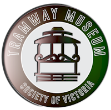Tramway Museum Society of Victoria Incorporated
38 Piccadilly Crescent, Keysborough, VIC 3173
Tramway Heritage Centre
330 Union Lane, Bylands, VIC 3762
Content copyright © Tramway Museum Society of Victoria Inc. Reproduced with permission.
ABN 12 739 015 600 Victorian Registration A1864E







December 23, 1923, marked the beginning of a new era for Melbourne's electric tramways -
Whereas the M&MTB inherited a wonderfully standard (extremely efficient) cable tram system, the electric tramways were a scattered collection of mostly small, independent units. Each had its own management thoughts, operating ideas, staff conditions. On union, each wanted to keeps its "good" points while adding an envied item from a neighbour. The result was a "shake-
Even the sketch designs for the "standard" trams had a protracted career. Many were prepared and rejected before final agreement was reach. But eventually the Nicholson Street cable tram workshops commenced fabrication of car underframes and trucks, and soon timber bodies were being built on the former in sheds erected behind the North Fitzroy cable tramcar barn. And from this beginning, in a workshop of doomed mode of transport, and in temporary sheds, there arose the second largest class of electric tramcars to be built in Australia (410 presently classed as W2 and SW2; Sydney had 626 O & OP cars), which, with direct derivatives, eventually totaled 760 trams. These makeshift premises eventually built about 46 W Class cars before the M&MTB's production was transferred to the new Preston Workshops.
Many modifications -
This screed is intended to note and commemorate the "Golden Anniversary" of the class of tramcar which has formed the backbone of the rolling stock of Melbourne's electric tramways since the early days of its "creator"; to record that 200 -
Today, half a century later, another new era is bursting upon Melbourne's tramways in the form of No. 1041. But before we move onwards and into the future, let us pause and reflect on the past, and quietly say "Thanks No. 219. Happy Birthday -
OUR ARCHIVES

| Our History |
| Our Funding |
| Rail Safety |
| Working Bee |
| Membership |
| Reflections |
| Previous Issues |
| Media |
| 2011 |
| 2010 |
| 2009 |
| 2007 |
| 2006 |
| 2005 |
| 2004 |
| 2003 |
| 2002 |
| 2001 |
| 2000 |
| 1999 |
| 1998 |
| 1997 |
| 1996 |
| 1995 |
| 1990 |
| 1989 |
| 1988 |
| 1987 |
| 1986 |
| 2011 |
| 2010 |
| 2009 |
| 2007 |
| 2006 |
| 2005 |
| 2004 |
| 2003 |
| 2002 |
| 2001 |
| 2000 |
| 1999 |
| 1998 |
| 1997 |
| 1996 |
| 1995 |
| 1990 |
| 1989 |
| 1988 |
| 1987 |
| 1986 |
| 1964-1965 |
| 1965-1966 |
| 1966-1967 |
| 1967-1968 |
| 1968-1969 |
| 1969 |
| 1972 |
| 1973 |